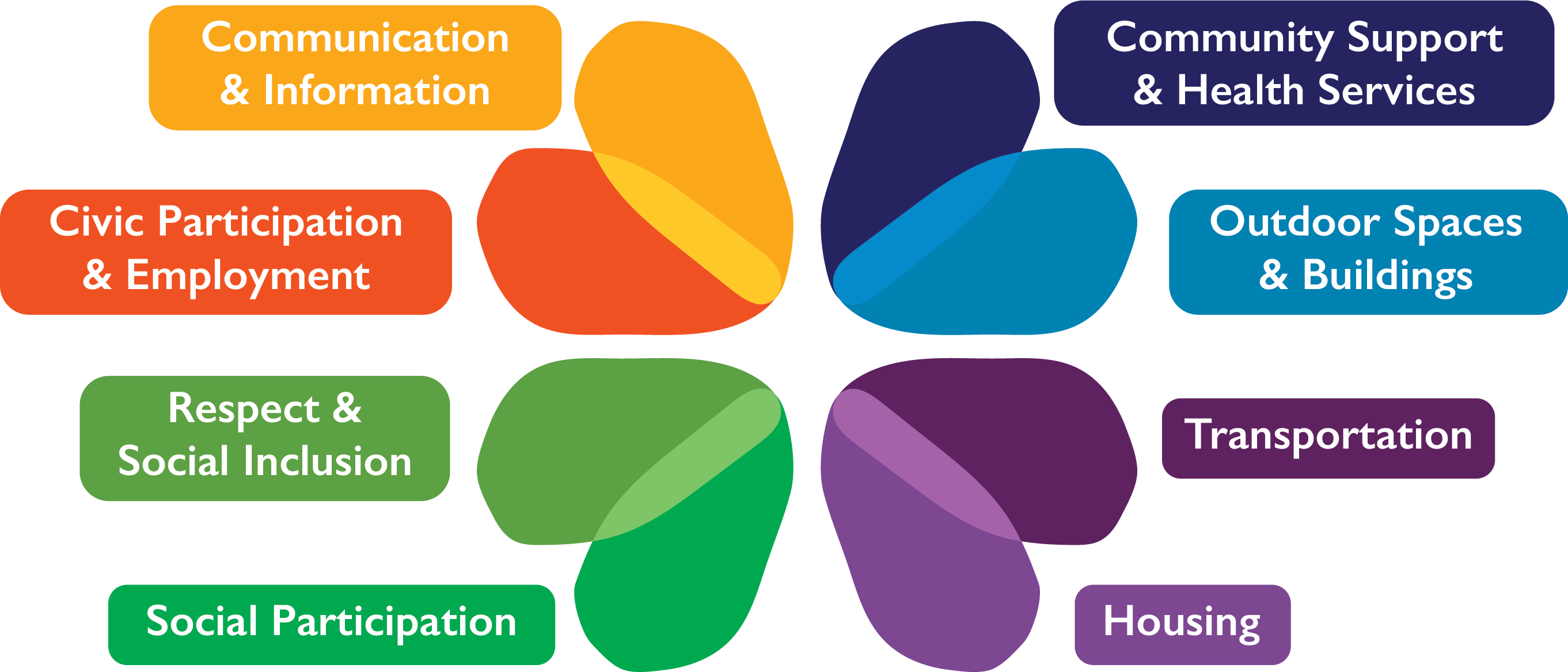8 Key Areas

The Eight Key Areas of Age-Friendly Communities
These Eight Key Areas focus on areas in our environment that can help older people live well. The improvements we make depend on what each community needs. Age-friendly Communities bring together different partners and older people to make these changes.
By focusing on these Eight Key Areas, Age-friendly Communities help older people live healthy, active, and engaged lives.
Click on the Key Areas names below to find out more information
Transport
Affordable, reliable, and convenient transport helps older people stay active and involved. Good transport is essential for shopping, meeting friends, and attending healthcare appointments.
An Age-friendly Community might:
- Promote Journey Assistance Cards for extra support on public transport.
- Create community transport options.
- Offer cycling classes for older adults.
Example: Isle of Wight trains its bus drivers to be age-friendly as part of their compulsory training.
Housing
The right housing helps older people live comfortably and safely in their community. Good housing can improve health and social connections.
An Age-friendly Community might:
- Create a list of reliable maintenance workers.
- Use a checklist to assess the suitability of homes for older people.
- Offer free advice on housing options.
Example: Greater Manchester’s framework supports diverse housing choices that promote social connections and independence.
Social Participation
Participating in community activities is important for health and wellbeing. Age-friendly communities make sure activities are accessible to everyone.
An Age-friendly Community might:
- Support initiatives for older residents to socialise and learn new skills.
- Work with local cafes and restaurants to provide chatter tables.
- Arrange intergenerational workshops.
Example: Leeds’ Shared Tables project invites older people to enjoy meals together at local restaurants.
Respect and Social Inclusion
Age-friendly communities include everyone and treat them with respect. They challenge negative stereotypes about ageing.
An Age-friendly Community might:
- Use positive images of older people in communications.
- Launch “Time for You” tills at supermarkets for those needing extra time.
- Celebrate older people's contributions through events.
Example: Our first Age Friendly Intergeneration event where we brought together Year 7 students from Thomas Alleyne Academy and our wonderful clients from Letchworth and Stevenage groups for a day of filled with laughter, learning, and connection.
Civic participation and employment
Age-friendly communities provide options for older people to continue working or volunteering. These activities benefit mental health and finances.
An Age-friendly Community might:
- Support local employers to become age-friendly.
- Offer employment support to older jobseekers.
- Advertise accessible volunteering opportunities.
Example: East Riding of Yorkshire promotes being an Age-friendly Employer through initiatives like Health MOTs and flexible retirement policies.
Communication and Information
Staying connected and getting timely information is crucial as we age. Age-friendly communities ensure information is accessible to everyone.
An Age-friendly Community might:
- Offer digital skills training for older people.
- Produce newsletters in print and digital formats.
- Run campaigns to ensure people know about benefits they’re entitled to.
Example: Newcastle, Hackney, and Bristol have radio programs focused on civic engagement for older listeners.
Community Support and Health Services
As the older population grows, the need for community support and health services increases. Age-friendly communities ensure health services are accessible and promote physical activity.
An Age-friendly Community might:
- Launch local walking sports clubs.
- Distribute information on staying safe and well, especially in winter.
- Make falls prevention programs appealing and accessible.
Example: Wigan has virtual bike rides to keep older people healthy in care homes.
Outdoor Spaces and Buildings
Public spaces and buildings affect our mobility, independence, and quality of life as we age. Age-friendly communities work to make these areas safe, accessible, and comfortable for everyone.
An Age-friendly Community might:
- Map out benches or toilets in the area.
- Work with local businesses to provide places to rest.
- Conduct walk audits with older people to improve pavements and crossings.
Example: Nottingham’s Take a Seat campaign has over 300 local spots offering a warm welcome and a seat to people when they’re out.